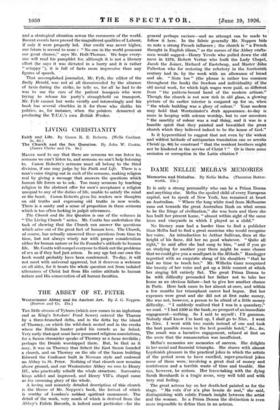THE ABBEY OF ST. PETER
Westminster Abbey and its Ancient Art. By J. G. Noppen. (Burrow and Co. 21s.) Westminster Abbey and its Ancient Art. By J. G. Noppen. (Burrow and Co. 21s.)
TUE little stream of Tyburn (which now comes to an inglorious end as King's Sci'a3lars' Pond Sewer) entered the Thames by a three-branched delta, and in the delta lay the island of Thorney, on which the wild-duck nested and in the creeks where the British hunter poled his coracle as he fished. Very early that, spot must have possessed religious associations, for a Saxon chronicler speaks of Thorny as a locus terrthilis perhaps the Druids worshipped there. But, be that as it may, it was on Thorney that Sebert the East Saxon founded a church, and on Thorney on the site of the Saxon building Edward the Confessor built in Norman style and endowed an Abbey to St. Peter. Nothing of that church now remains above ground,. and our Westminster Abbey we owe to Henry III., who practically rebuilt the whole structure. Successive kings added and improved, and Henry VII's. chapel came as the crowning glory of the whole.
A loving and minutely detailed description of this church is the theme of Mr. Noppen's book, the format of which is Worthy of. Londens noblest spiritual monunaent. The detail of the work, very much of which is derived from the Abbey's Fabric Records, is indeed most particular--for the
general perhaps caviare—and no attempt can be made to follow it here. In the fabric generally. Mr. Noppen bids us note a strong French influence ; the chuich is " a French thought in English idiom," as the names of the Abbey crafts- men would suggest—Henry Yevele who pulled down the old nave in 1376, Robert Vertue who built the -Lady Chapel, Jacob the Joiner, Richard of Eastcheap, and. Master -John Palterton who for restoring the refectory in the fourteenth century had 2s: by the week with an allowance of bread and ale. " Note too " (the phrase is. rather too common' throughout the book) the freedom and individualitY Of the old metal work, for which high wages were paid, so different from " the . pattern-bound hand of the modern artisan." Though the church is not now rich in old glass, a glowing picture of its earlier interior is -conjured up -for us, when " the whole building was a glory of colour." Your modern may hold- that Westminster's drab appearance ,- hi-day is more in keeping with solemn worship, but -to our ancestors " the sanctity of colour was a = real thing, and it was in a humble spirit that they painted and beautified the great church which they *believed-indeed to be the house of God."
Is it hypercritical is suggest that not even by 'Vie— Widest and wildest latitude of antiquarian translation can ne servitio Christi (p. 80) be construed " that the resident brothers might not be hindered in the service of Christ ? " Or is-there some omission or corruption in the Latin- citation4 -










































 Previous page
Previous page